University Commercial Banking: Risk Management and Interrelationships
VerifiedAdded on 2022/08/19
|11
|2177
|11
Report
AI Summary
This report provides an assessment of the risk management models employed by commercial banks. It begins with an executive summary that outlines the paper's objectives, which include identifying the various risks faced by banks and evaluating the interrelationships between these risks. The report then dives into a detailed discussion of the different types of risks, such as liquidity risk, price risk, credit risk, interest rate risk, and transaction risk, and analyzes how these risks are interconnected. Furthermore, the report assesses the completeness of the risk management models used by banks in measuring and mitigating these risks, using examples to demonstrate the models' limitations. The analysis emphasizes that the various risk exposures are often interrelated, and the models that only focus on one type of risk are incomplete. The conclusion summarizes the key findings, reiterating the interrelationship of risks and the importance of comprehensive risk management models. The report also includes a comprehensive list of references.
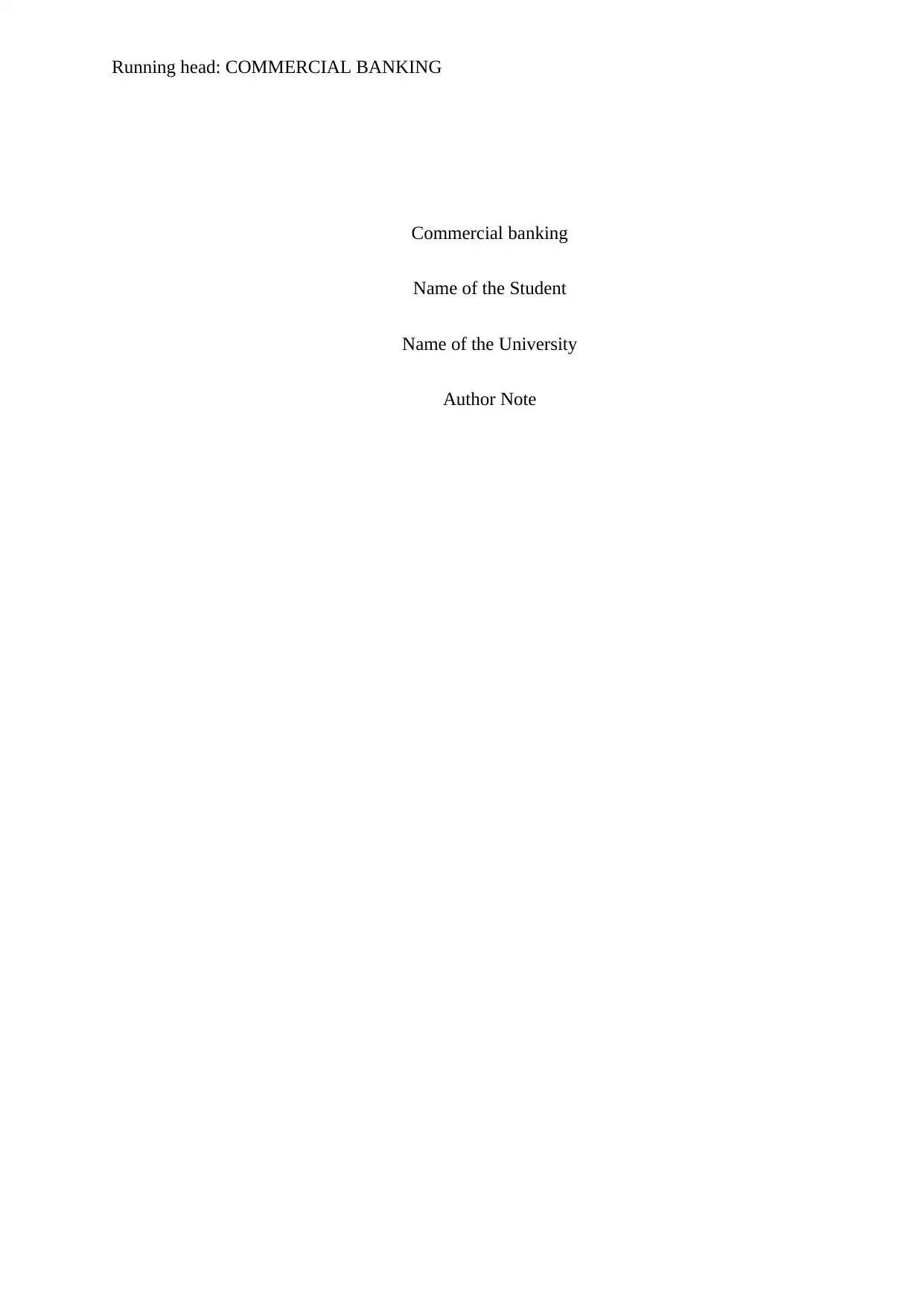
Running head: COMMERCIAL BANKING
Commercial banking
Name of the Student
Name of the University
Author Note
Commercial banking
Name of the Student
Name of the University
Author Note
Paraphrase This Document
Need a fresh take? Get an instant paraphrase of this document with our AI Paraphraser
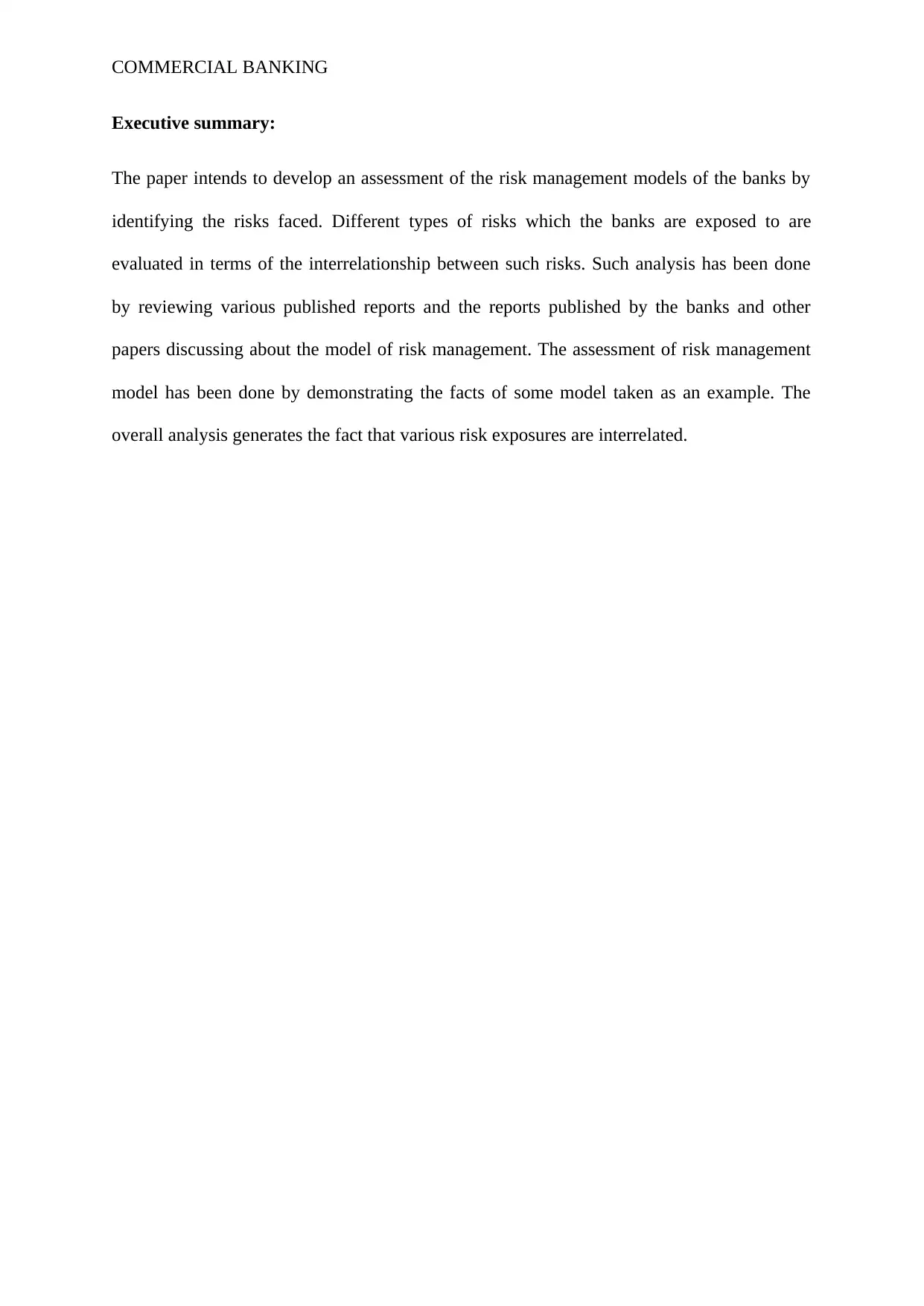
COMMERCIAL BANKING
Executive summary:
The paper intends to develop an assessment of the risk management models of the banks by
identifying the risks faced. Different types of risks which the banks are exposed to are
evaluated in terms of the interrelationship between such risks. Such analysis has been done
by reviewing various published reports and the reports published by the banks and other
papers discussing about the model of risk management. The assessment of risk management
model has been done by demonstrating the facts of some model taken as an example. The
overall analysis generates the fact that various risk exposures are interrelated.
Executive summary:
The paper intends to develop an assessment of the risk management models of the banks by
identifying the risks faced. Different types of risks which the banks are exposed to are
evaluated in terms of the interrelationship between such risks. Such analysis has been done
by reviewing various published reports and the reports published by the banks and other
papers discussing about the model of risk management. The assessment of risk management
model has been done by demonstrating the facts of some model taken as an example. The
overall analysis generates the fact that various risk exposures are interrelated.
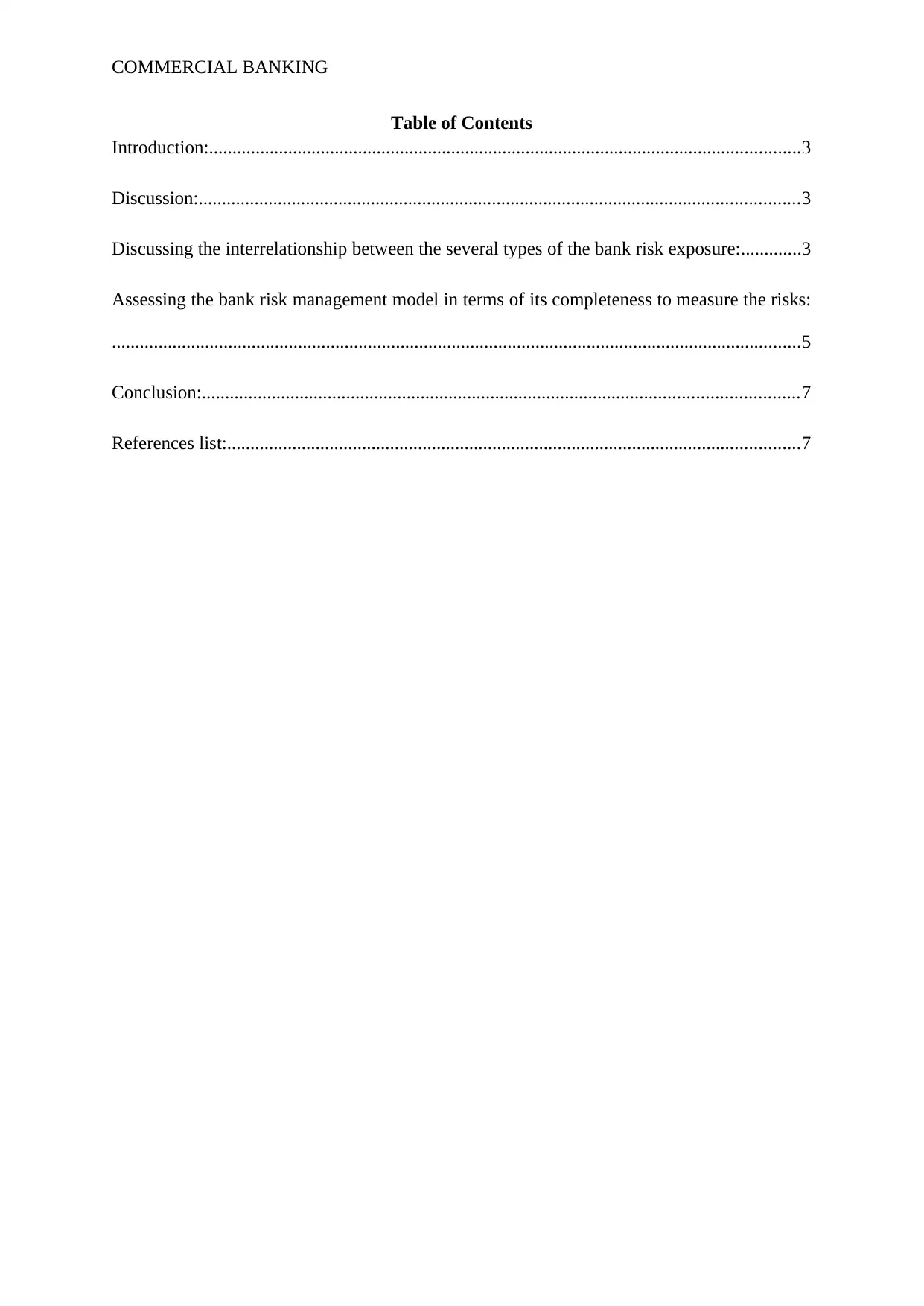
COMMERCIAL BANKING
Table of Contents
Introduction:...............................................................................................................................3
Discussion:.................................................................................................................................3
Discussing the interrelationship between the several types of the bank risk exposure:.............3
Assessing the bank risk management model in terms of its completeness to measure the risks:
....................................................................................................................................................5
Conclusion:................................................................................................................................7
References list:...........................................................................................................................7
Table of Contents
Introduction:...............................................................................................................................3
Discussion:.................................................................................................................................3
Discussing the interrelationship between the several types of the bank risk exposure:.............3
Assessing the bank risk management model in terms of its completeness to measure the risks:
....................................................................................................................................................5
Conclusion:................................................................................................................................7
References list:...........................................................................................................................7
You're viewing a preview
Unlock full access by subscribing today!
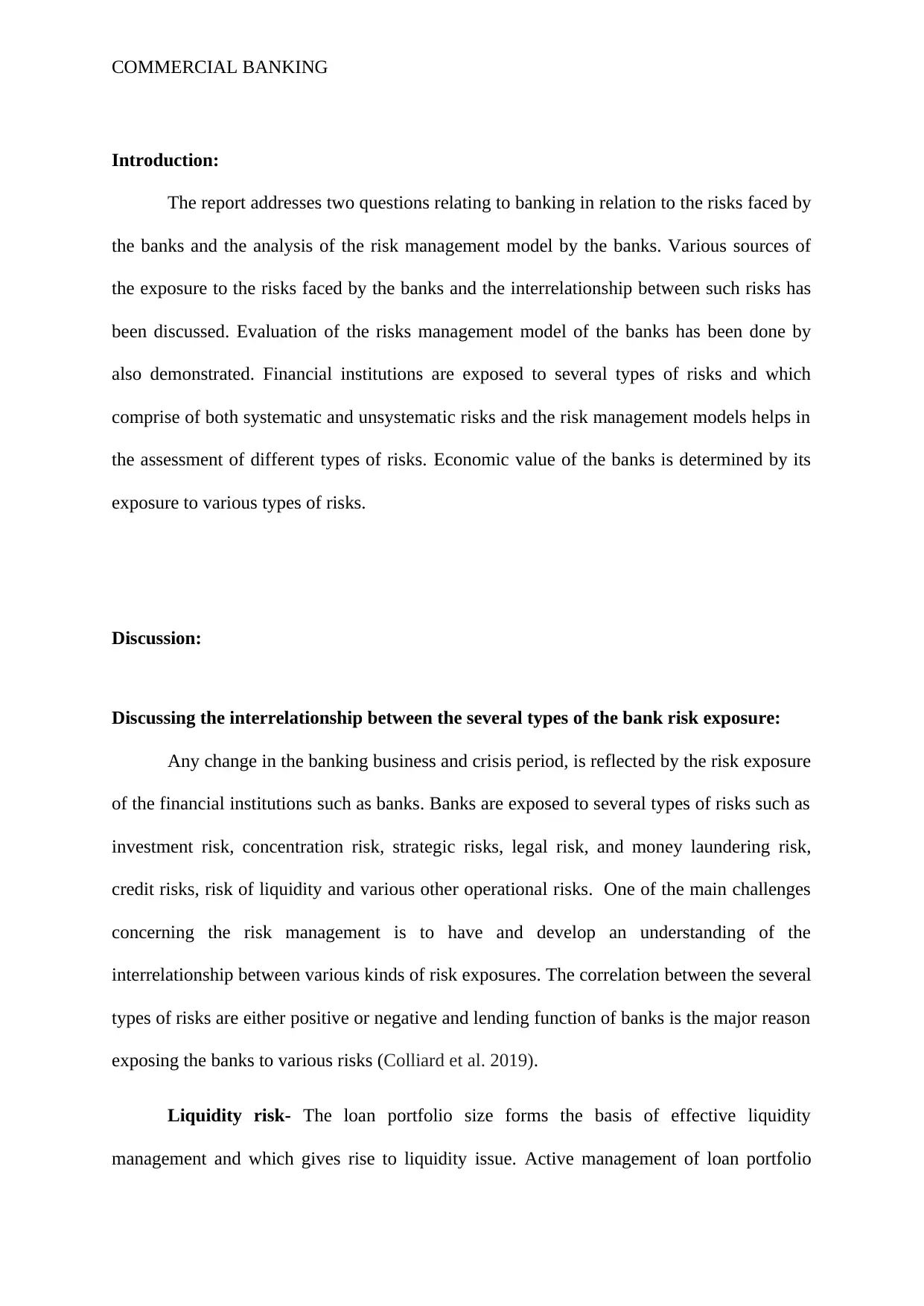
COMMERCIAL BANKING
Introduction:
The report addresses two questions relating to banking in relation to the risks faced by
the banks and the analysis of the risk management model by the banks. Various sources of
the exposure to the risks faced by the banks and the interrelationship between such risks has
been discussed. Evaluation of the risks management model of the banks has been done by
also demonstrated. Financial institutions are exposed to several types of risks and which
comprise of both systematic and unsystematic risks and the risk management models helps in
the assessment of different types of risks. Economic value of the banks is determined by its
exposure to various types of risks.
Discussion:
Discussing the interrelationship between the several types of the bank risk exposure:
Any change in the banking business and crisis period, is reflected by the risk exposure
of the financial institutions such as banks. Banks are exposed to several types of risks such as
investment risk, concentration risk, strategic risks, legal risk, and money laundering risk,
credit risks, risk of liquidity and various other operational risks. One of the main challenges
concerning the risk management is to have and develop an understanding of the
interrelationship between various kinds of risk exposures. The correlation between the several
types of risks are either positive or negative and lending function of banks is the major reason
exposing the banks to various risks (Colliard et al. 2019).
Liquidity risk- The loan portfolio size forms the basis of effective liquidity
management and which gives rise to liquidity issue. Active management of loan portfolio
Introduction:
The report addresses two questions relating to banking in relation to the risks faced by
the banks and the analysis of the risk management model by the banks. Various sources of
the exposure to the risks faced by the banks and the interrelationship between such risks has
been discussed. Evaluation of the risks management model of the banks has been done by
also demonstrated. Financial institutions are exposed to several types of risks and which
comprise of both systematic and unsystematic risks and the risk management models helps in
the assessment of different types of risks. Economic value of the banks is determined by its
exposure to various types of risks.
Discussion:
Discussing the interrelationship between the several types of the bank risk exposure:
Any change in the banking business and crisis period, is reflected by the risk exposure
of the financial institutions such as banks. Banks are exposed to several types of risks such as
investment risk, concentration risk, strategic risks, legal risk, and money laundering risk,
credit risks, risk of liquidity and various other operational risks. One of the main challenges
concerning the risk management is to have and develop an understanding of the
interrelationship between various kinds of risk exposures. The correlation between the several
types of risks are either positive or negative and lending function of banks is the major reason
exposing the banks to various risks (Colliard et al. 2019).
Liquidity risk- The loan portfolio size forms the basis of effective liquidity
management and which gives rise to liquidity issue. Active management of loan portfolio
Paraphrase This Document
Need a fresh take? Get an instant paraphrase of this document with our AI Paraphraser
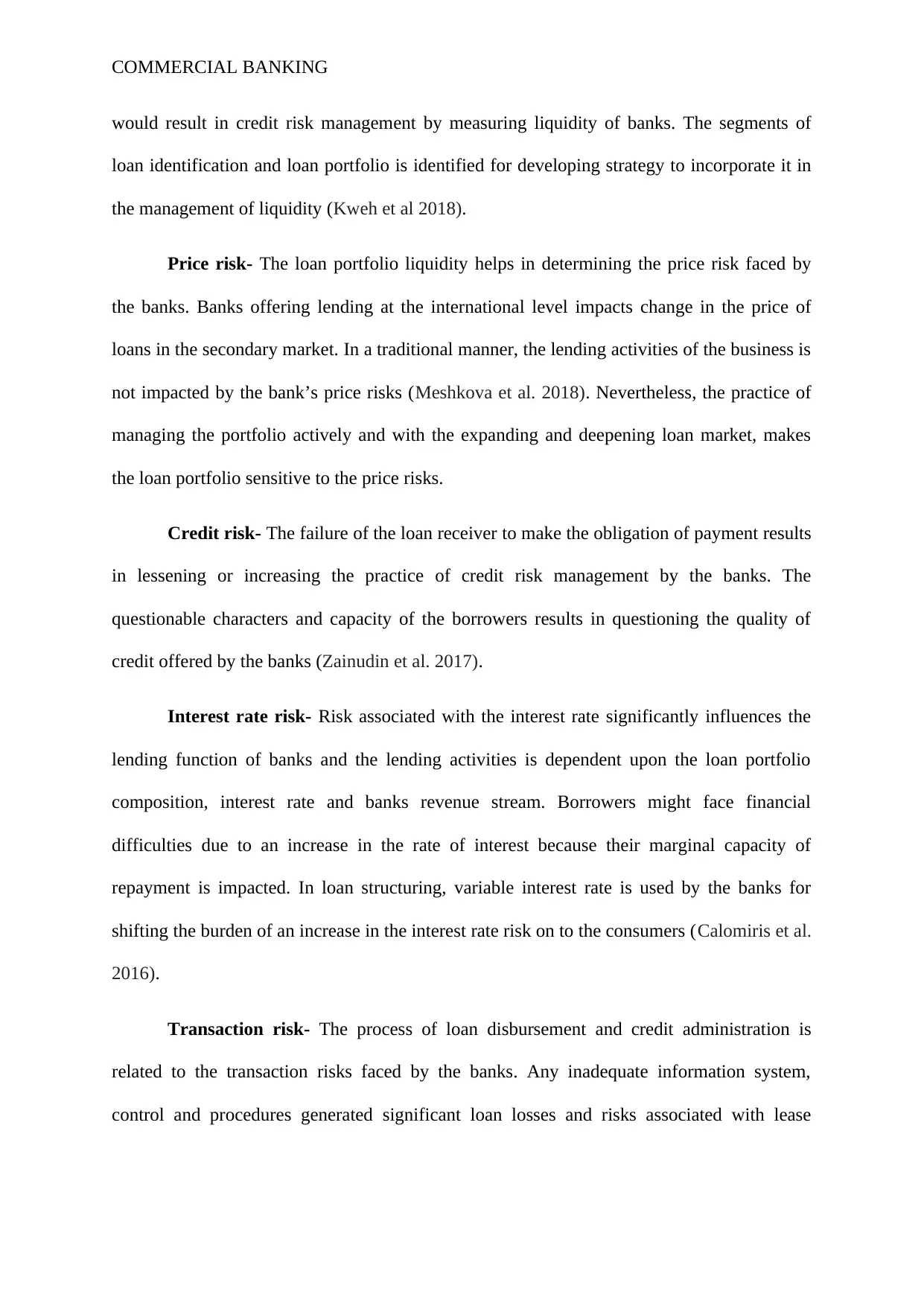
COMMERCIAL BANKING
would result in credit risk management by measuring liquidity of banks. The segments of
loan identification and loan portfolio is identified for developing strategy to incorporate it in
the management of liquidity (Kweh et al 2018).
Price risk- The loan portfolio liquidity helps in determining the price risk faced by
the banks. Banks offering lending at the international level impacts change in the price of
loans in the secondary market. In a traditional manner, the lending activities of the business is
not impacted by the bank’s price risks (Meshkova et al. 2018). Nevertheless, the practice of
managing the portfolio actively and with the expanding and deepening loan market, makes
the loan portfolio sensitive to the price risks.
Credit risk- The failure of the loan receiver to make the obligation of payment results
in lessening or increasing the practice of credit risk management by the banks. The
questionable characters and capacity of the borrowers results in questioning the quality of
credit offered by the banks (Zainudin et al. 2017).
Interest rate risk- Risk associated with the interest rate significantly influences the
lending function of banks and the lending activities is dependent upon the loan portfolio
composition, interest rate and banks revenue stream. Borrowers might face financial
difficulties due to an increase in the rate of interest because their marginal capacity of
repayment is impacted. In loan structuring, variable interest rate is used by the banks for
shifting the burden of an increase in the interest rate risk on to the consumers (Calomiris et al.
2016).
Transaction risk- The process of loan disbursement and credit administration is
related to the transaction risks faced by the banks. Any inadequate information system,
control and procedures generated significant loan losses and risks associated with lease
would result in credit risk management by measuring liquidity of banks. The segments of
loan identification and loan portfolio is identified for developing strategy to incorporate it in
the management of liquidity (Kweh et al 2018).
Price risk- The loan portfolio liquidity helps in determining the price risk faced by
the banks. Banks offering lending at the international level impacts change in the price of
loans in the secondary market. In a traditional manner, the lending activities of the business is
not impacted by the bank’s price risks (Meshkova et al. 2018). Nevertheless, the practice of
managing the portfolio actively and with the expanding and deepening loan market, makes
the loan portfolio sensitive to the price risks.
Credit risk- The failure of the loan receiver to make the obligation of payment results
in lessening or increasing the practice of credit risk management by the banks. The
questionable characters and capacity of the borrowers results in questioning the quality of
credit offered by the banks (Zainudin et al. 2017).
Interest rate risk- Risk associated with the interest rate significantly influences the
lending function of banks and the lending activities is dependent upon the loan portfolio
composition, interest rate and banks revenue stream. Borrowers might face financial
difficulties due to an increase in the rate of interest because their marginal capacity of
repayment is impacted. In loan structuring, variable interest rate is used by the banks for
shifting the burden of an increase in the interest rate risk on to the consumers (Calomiris et al.
2016).
Transaction risk- The process of loan disbursement and credit administration is
related to the transaction risks faced by the banks. Any inadequate information system,
control and procedures generated significant loan losses and risks associated with lease
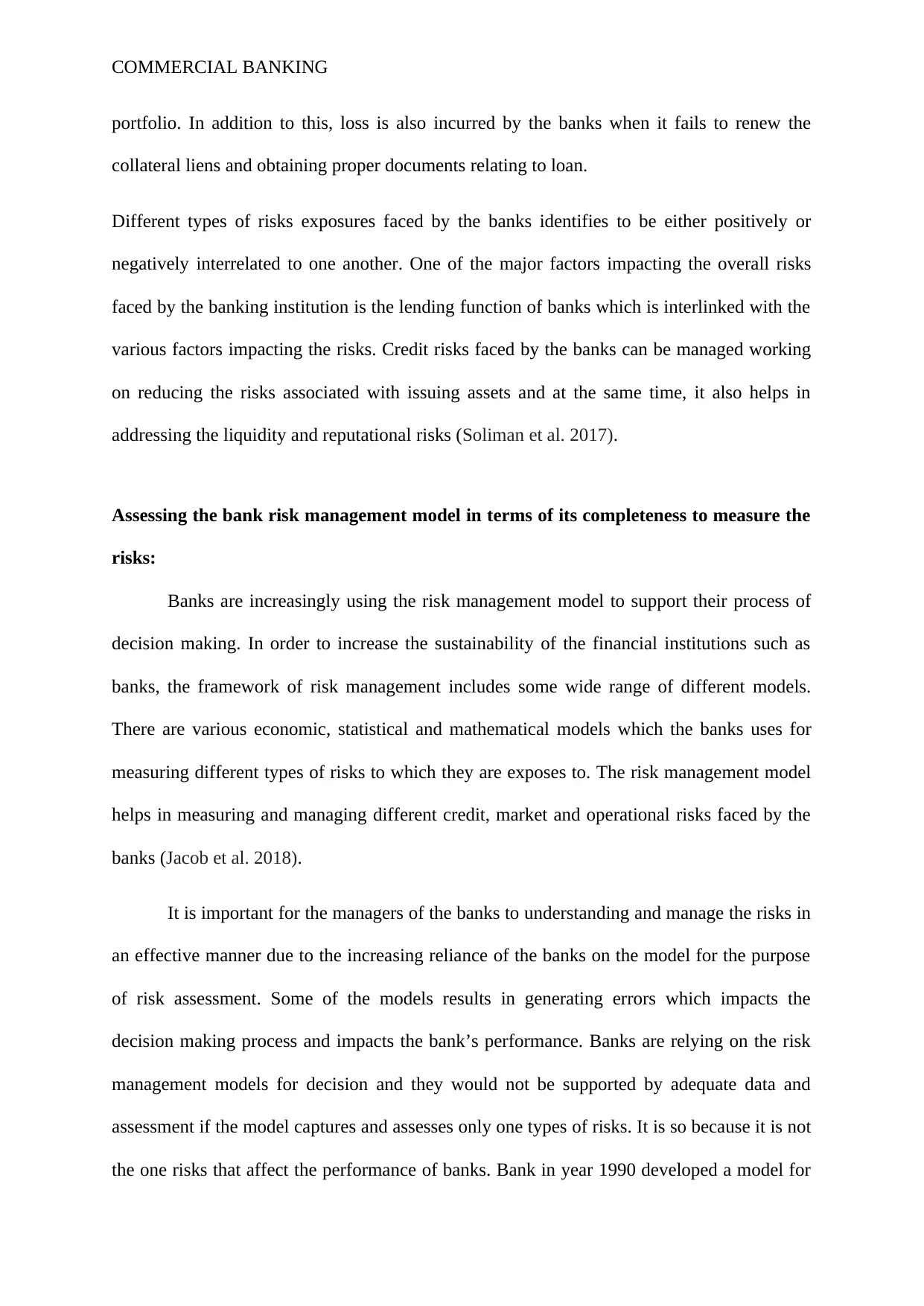
COMMERCIAL BANKING
portfolio. In addition to this, loss is also incurred by the banks when it fails to renew the
collateral liens and obtaining proper documents relating to loan.
Different types of risks exposures faced by the banks identifies to be either positively or
negatively interrelated to one another. One of the major factors impacting the overall risks
faced by the banking institution is the lending function of banks which is interlinked with the
various factors impacting the risks. Credit risks faced by the banks can be managed working
on reducing the risks associated with issuing assets and at the same time, it also helps in
addressing the liquidity and reputational risks (Soliman et al. 2017).
Assessing the bank risk management model in terms of its completeness to measure the
risks:
Banks are increasingly using the risk management model to support their process of
decision making. In order to increase the sustainability of the financial institutions such as
banks, the framework of risk management includes some wide range of different models.
There are various economic, statistical and mathematical models which the banks uses for
measuring different types of risks to which they are exposes to. The risk management model
helps in measuring and managing different credit, market and operational risks faced by the
banks (Jacob et al. 2018).
It is important for the managers of the banks to understanding and manage the risks in
an effective manner due to the increasing reliance of the banks on the model for the purpose
of risk assessment. Some of the models results in generating errors which impacts the
decision making process and impacts the bank’s performance. Banks are relying on the risk
management models for decision and they would not be supported by adequate data and
assessment if the model captures and assesses only one types of risks. It is so because it is not
the one risks that affect the performance of banks. Bank in year 1990 developed a model for
portfolio. In addition to this, loss is also incurred by the banks when it fails to renew the
collateral liens and obtaining proper documents relating to loan.
Different types of risks exposures faced by the banks identifies to be either positively or
negatively interrelated to one another. One of the major factors impacting the overall risks
faced by the banking institution is the lending function of banks which is interlinked with the
various factors impacting the risks. Credit risks faced by the banks can be managed working
on reducing the risks associated with issuing assets and at the same time, it also helps in
addressing the liquidity and reputational risks (Soliman et al. 2017).
Assessing the bank risk management model in terms of its completeness to measure the
risks:
Banks are increasingly using the risk management model to support their process of
decision making. In order to increase the sustainability of the financial institutions such as
banks, the framework of risk management includes some wide range of different models.
There are various economic, statistical and mathematical models which the banks uses for
measuring different types of risks to which they are exposes to. The risk management model
helps in measuring and managing different credit, market and operational risks faced by the
banks (Jacob et al. 2018).
It is important for the managers of the banks to understanding and manage the risks in
an effective manner due to the increasing reliance of the banks on the model for the purpose
of risk assessment. Some of the models results in generating errors which impacts the
decision making process and impacts the bank’s performance. Banks are relying on the risk
management models for decision and they would not be supported by adequate data and
assessment if the model captures and assesses only one types of risks. It is so because it is not
the one risks that affect the performance of banks. Bank in year 1990 developed a model for
You're viewing a preview
Unlock full access by subscribing today!
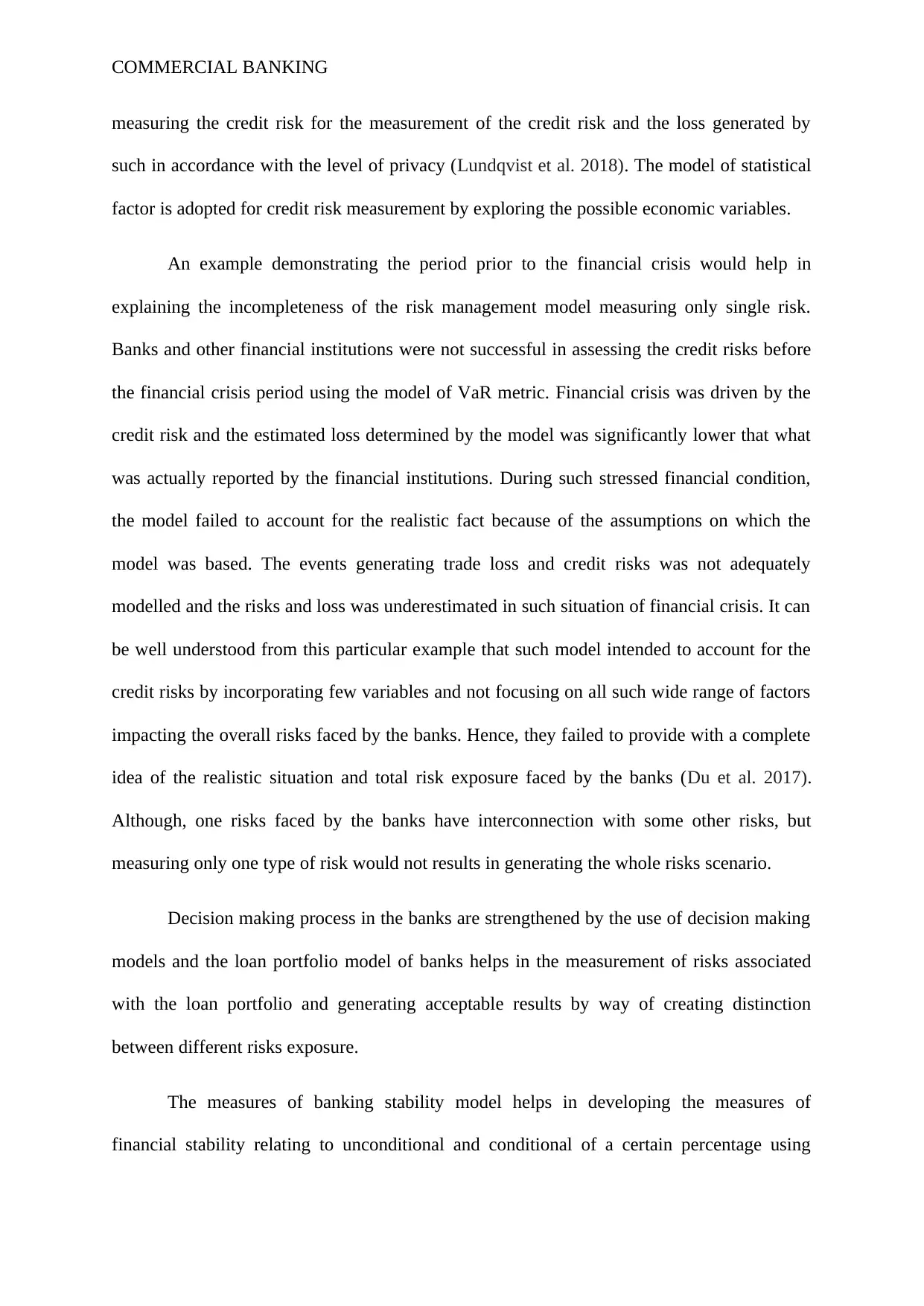
COMMERCIAL BANKING
measuring the credit risk for the measurement of the credit risk and the loss generated by
such in accordance with the level of privacy (Lundqvist et al. 2018). The model of statistical
factor is adopted for credit risk measurement by exploring the possible economic variables.
An example demonstrating the period prior to the financial crisis would help in
explaining the incompleteness of the risk management model measuring only single risk.
Banks and other financial institutions were not successful in assessing the credit risks before
the financial crisis period using the model of VaR metric. Financial crisis was driven by the
credit risk and the estimated loss determined by the model was significantly lower that what
was actually reported by the financial institutions. During such stressed financial condition,
the model failed to account for the realistic fact because of the assumptions on which the
model was based. The events generating trade loss and credit risks was not adequately
modelled and the risks and loss was underestimated in such situation of financial crisis. It can
be well understood from this particular example that such model intended to account for the
credit risks by incorporating few variables and not focusing on all such wide range of factors
impacting the overall risks faced by the banks. Hence, they failed to provide with a complete
idea of the realistic situation and total risk exposure faced by the banks (Du et al. 2017).
Although, one risks faced by the banks have interconnection with some other risks, but
measuring only one type of risk would not results in generating the whole risks scenario.
Decision making process in the banks are strengthened by the use of decision making
models and the loan portfolio model of banks helps in the measurement of risks associated
with the loan portfolio and generating acceptable results by way of creating distinction
between different risks exposure.
The measures of banking stability model helps in developing the measures of
financial stability relating to unconditional and conditional of a certain percentage using
measuring the credit risk for the measurement of the credit risk and the loss generated by
such in accordance with the level of privacy (Lundqvist et al. 2018). The model of statistical
factor is adopted for credit risk measurement by exploring the possible economic variables.
An example demonstrating the period prior to the financial crisis would help in
explaining the incompleteness of the risk management model measuring only single risk.
Banks and other financial institutions were not successful in assessing the credit risks before
the financial crisis period using the model of VaR metric. Financial crisis was driven by the
credit risk and the estimated loss determined by the model was significantly lower that what
was actually reported by the financial institutions. During such stressed financial condition,
the model failed to account for the realistic fact because of the assumptions on which the
model was based. The events generating trade loss and credit risks was not adequately
modelled and the risks and loss was underestimated in such situation of financial crisis. It can
be well understood from this particular example that such model intended to account for the
credit risks by incorporating few variables and not focusing on all such wide range of factors
impacting the overall risks faced by the banks. Hence, they failed to provide with a complete
idea of the realistic situation and total risk exposure faced by the banks (Du et al. 2017).
Although, one risks faced by the banks have interconnection with some other risks, but
measuring only one type of risk would not results in generating the whole risks scenario.
Decision making process in the banks are strengthened by the use of decision making
models and the loan portfolio model of banks helps in the measurement of risks associated
with the loan portfolio and generating acceptable results by way of creating distinction
between different risks exposure.
The measures of banking stability model helps in developing the measures of
financial stability relating to unconditional and conditional of a certain percentage using
Paraphrase This Document
Need a fresh take? Get an instant paraphrase of this document with our AI Paraphraser
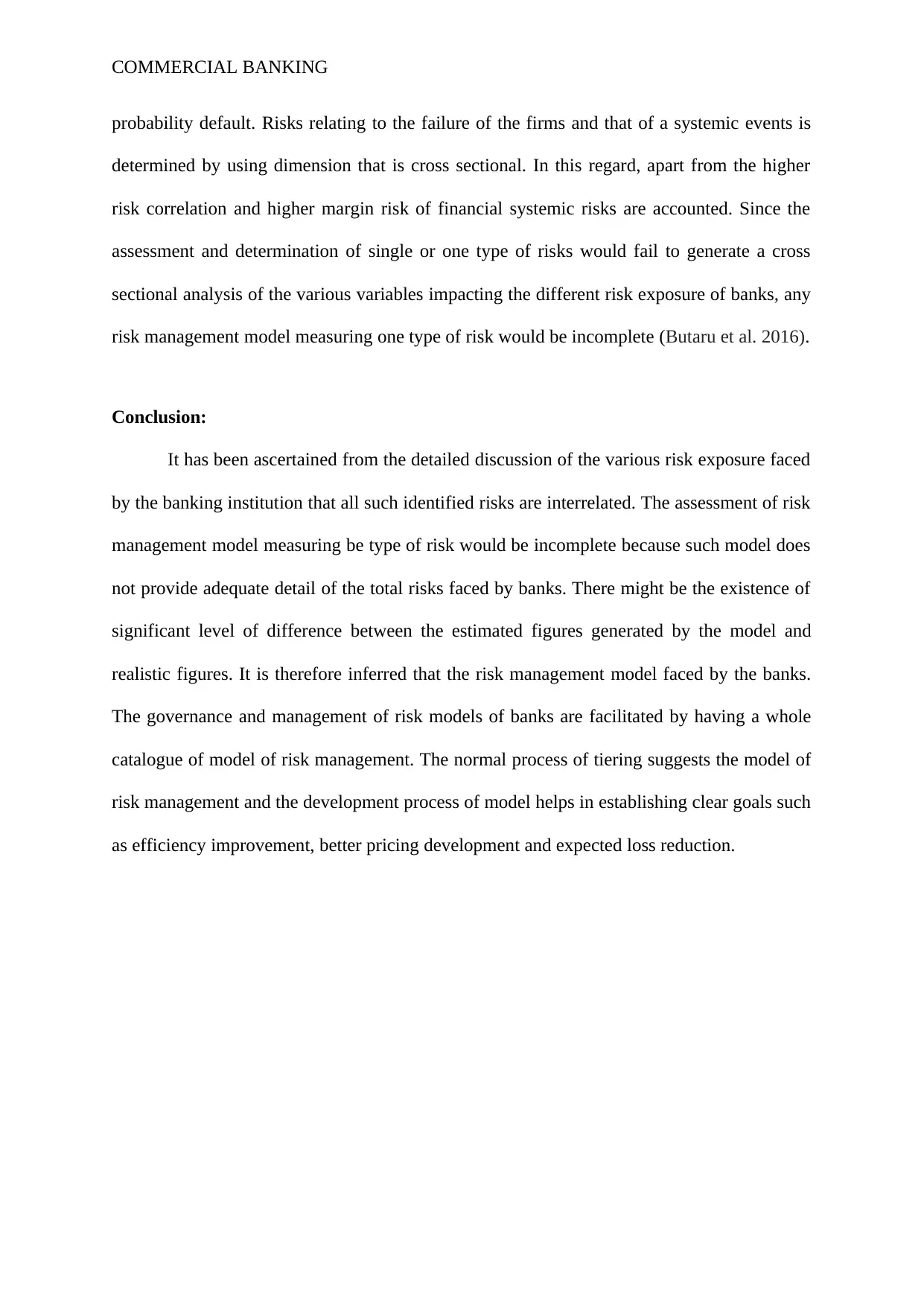
COMMERCIAL BANKING
probability default. Risks relating to the failure of the firms and that of a systemic events is
determined by using dimension that is cross sectional. In this regard, apart from the higher
risk correlation and higher margin risk of financial systemic risks are accounted. Since the
assessment and determination of single or one type of risks would fail to generate a cross
sectional analysis of the various variables impacting the different risk exposure of banks, any
risk management model measuring one type of risk would be incomplete (Butaru et al. 2016).
Conclusion:
It has been ascertained from the detailed discussion of the various risk exposure faced
by the banking institution that all such identified risks are interrelated. The assessment of risk
management model measuring be type of risk would be incomplete because such model does
not provide adequate detail of the total risks faced by banks. There might be the existence of
significant level of difference between the estimated figures generated by the model and
realistic figures. It is therefore inferred that the risk management model faced by the banks.
The governance and management of risk models of banks are facilitated by having a whole
catalogue of model of risk management. The normal process of tiering suggests the model of
risk management and the development process of model helps in establishing clear goals such
as efficiency improvement, better pricing development and expected loss reduction.
probability default. Risks relating to the failure of the firms and that of a systemic events is
determined by using dimension that is cross sectional. In this regard, apart from the higher
risk correlation and higher margin risk of financial systemic risks are accounted. Since the
assessment and determination of single or one type of risks would fail to generate a cross
sectional analysis of the various variables impacting the different risk exposure of banks, any
risk management model measuring one type of risk would be incomplete (Butaru et al. 2016).
Conclusion:
It has been ascertained from the detailed discussion of the various risk exposure faced
by the banking institution that all such identified risks are interrelated. The assessment of risk
management model measuring be type of risk would be incomplete because such model does
not provide adequate detail of the total risks faced by banks. There might be the existence of
significant level of difference between the estimated figures generated by the model and
realistic figures. It is therefore inferred that the risk management model faced by the banks.
The governance and management of risk models of banks are facilitated by having a whole
catalogue of model of risk management. The normal process of tiering suggests the model of
risk management and the development process of model helps in establishing clear goals such
as efficiency improvement, better pricing development and expected loss reduction.

COMMERCIAL BANKING
You're viewing a preview
Unlock full access by subscribing today!
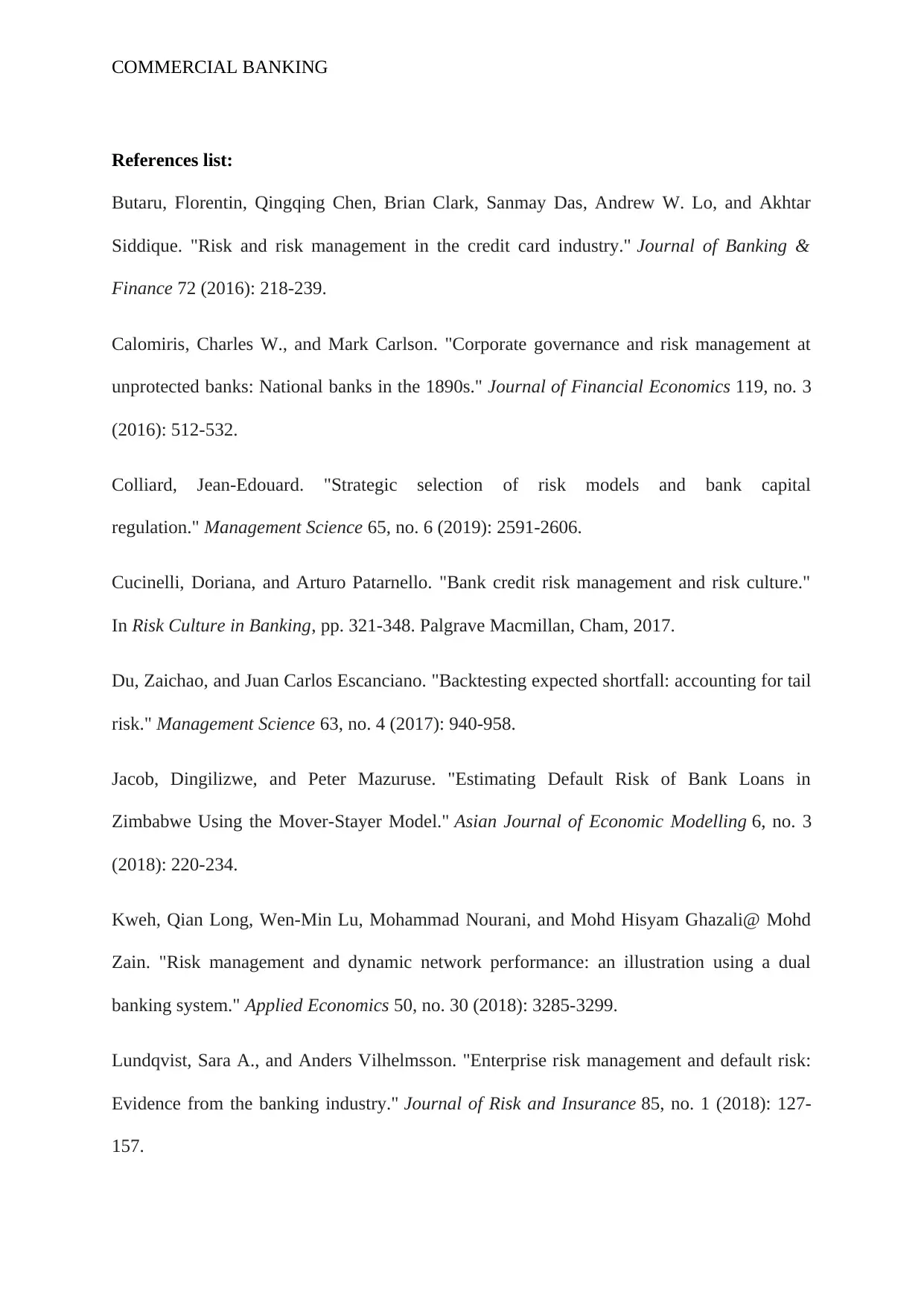
COMMERCIAL BANKING
References list:
Butaru, Florentin, Qingqing Chen, Brian Clark, Sanmay Das, Andrew W. Lo, and Akhtar
Siddique. "Risk and risk management in the credit card industry." Journal of Banking &
Finance 72 (2016): 218-239.
Calomiris, Charles W., and Mark Carlson. "Corporate governance and risk management at
unprotected banks: National banks in the 1890s." Journal of Financial Economics 119, no. 3
(2016): 512-532.
Colliard, Jean-Edouard. "Strategic selection of risk models and bank capital
regulation." Management Science 65, no. 6 (2019): 2591-2606.
Cucinelli, Doriana, and Arturo Patarnello. "Bank credit risk management and risk culture."
In Risk Culture in Banking, pp. 321-348. Palgrave Macmillan, Cham, 2017.
Du, Zaichao, and Juan Carlos Escanciano. "Backtesting expected shortfall: accounting for tail
risk." Management Science 63, no. 4 (2017): 940-958.
Jacob, Dingilizwe, and Peter Mazuruse. "Estimating Default Risk of Bank Loans in
Zimbabwe Using the Mover-Stayer Model." Asian Journal of Economic Modelling 6, no. 3
(2018): 220-234.
Kweh, Qian Long, Wen-Min Lu, Mohammad Nourani, and Mohd Hisyam Ghazali@ Mohd
Zain. "Risk management and dynamic network performance: an illustration using a dual
banking system." Applied Economics 50, no. 30 (2018): 3285-3299.
Lundqvist, Sara A., and Anders Vilhelmsson. "Enterprise risk management and default risk:
Evidence from the banking industry." Journal of Risk and Insurance 85, no. 1 (2018): 127-
157.
References list:
Butaru, Florentin, Qingqing Chen, Brian Clark, Sanmay Das, Andrew W. Lo, and Akhtar
Siddique. "Risk and risk management in the credit card industry." Journal of Banking &
Finance 72 (2016): 218-239.
Calomiris, Charles W., and Mark Carlson. "Corporate governance and risk management at
unprotected banks: National banks in the 1890s." Journal of Financial Economics 119, no. 3
(2016): 512-532.
Colliard, Jean-Edouard. "Strategic selection of risk models and bank capital
regulation." Management Science 65, no. 6 (2019): 2591-2606.
Cucinelli, Doriana, and Arturo Patarnello. "Bank credit risk management and risk culture."
In Risk Culture in Banking, pp. 321-348. Palgrave Macmillan, Cham, 2017.
Du, Zaichao, and Juan Carlos Escanciano. "Backtesting expected shortfall: accounting for tail
risk." Management Science 63, no. 4 (2017): 940-958.
Jacob, Dingilizwe, and Peter Mazuruse. "Estimating Default Risk of Bank Loans in
Zimbabwe Using the Mover-Stayer Model." Asian Journal of Economic Modelling 6, no. 3
(2018): 220-234.
Kweh, Qian Long, Wen-Min Lu, Mohammad Nourani, and Mohd Hisyam Ghazali@ Mohd
Zain. "Risk management and dynamic network performance: an illustration using a dual
banking system." Applied Economics 50, no. 30 (2018): 3285-3299.
Lundqvist, Sara A., and Anders Vilhelmsson. "Enterprise risk management and default risk:
Evidence from the banking industry." Journal of Risk and Insurance 85, no. 1 (2018): 127-
157.
Paraphrase This Document
Need a fresh take? Get an instant paraphrase of this document with our AI Paraphraser
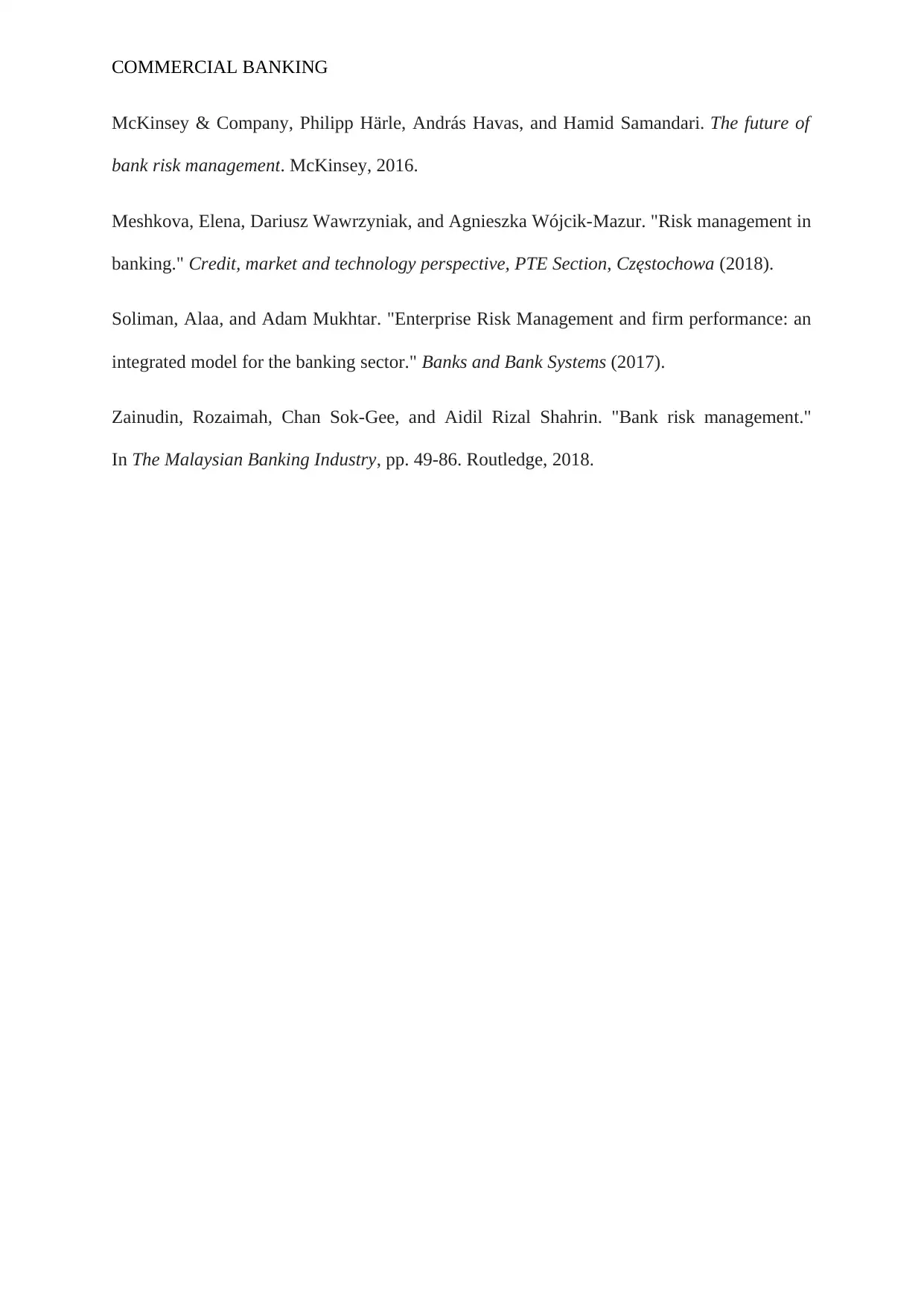
COMMERCIAL BANKING
McKinsey & Company, Philipp Härle, András Havas, and Hamid Samandari. The future of
bank risk management. McKinsey, 2016.
Meshkova, Elena, Dariusz Wawrzyniak, and Agnieszka Wójcik-Mazur. "Risk management in
banking." Credit, market and technology perspective, PTE Section, Częstochowa (2018).
Soliman, Alaa, and Adam Mukhtar. "Enterprise Risk Management and firm performance: an
integrated model for the banking sector." Banks and Bank Systems (2017).
Zainudin, Rozaimah, Chan Sok-Gee, and Aidil Rizal Shahrin. "Bank risk management."
In The Malaysian Banking Industry, pp. 49-86. Routledge, 2018.
McKinsey & Company, Philipp Härle, András Havas, and Hamid Samandari. The future of
bank risk management. McKinsey, 2016.
Meshkova, Elena, Dariusz Wawrzyniak, and Agnieszka Wójcik-Mazur. "Risk management in
banking." Credit, market and technology perspective, PTE Section, Częstochowa (2018).
Soliman, Alaa, and Adam Mukhtar. "Enterprise Risk Management and firm performance: an
integrated model for the banking sector." Banks and Bank Systems (2017).
Zainudin, Rozaimah, Chan Sok-Gee, and Aidil Rizal Shahrin. "Bank risk management."
In The Malaysian Banking Industry, pp. 49-86. Routledge, 2018.
1 out of 11
Related Documents
Your All-in-One AI-Powered Toolkit for Academic Success.
+13062052269
info@desklib.com
Available 24*7 on WhatsApp / Email
![[object Object]](/_next/static/media/star-bottom.7253800d.svg)
Unlock your academic potential
© 2024 | Zucol Services PVT LTD | All rights reserved.





